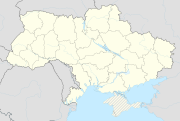Kilija
| Kilija | ||
| Кілія | ||

|
|
|
| Basic data | ||
|---|---|---|
| Oblast : | Odessa Oblast | |
| Rajon : | Kilija district | |
| Height : | 5 m | |
| Area : | 195 km² | |
| Residents : | 22,884 (2004) | |
| Population density : | 117 inhabitants per km² | |
| Postcodes : | 68309 | |
| Area code : | +380 4843 | |
| Geographic location : | 45 ° 27 ' N , 29 ° 16' E | |
| KOATUU : | 5122310100 | |
| Administrative structure : | 1 city | |
| Mayor : | Valentyn Boborowskyj | |
| Address: | вул. Леніна 57 68300 м. Кілія |
|
| Statistical information | ||
|
|
||
Kilija ( Ukrainian Кілія ; Russian Килия , Romanian Chilia (Nouă) ) is a Ukrainian city on the northern bank of the Kilijaarm , a delta estuary of the Danube . It is located near the Romanian border .
Kilija was an important trading town in the Danube Delta, on the northern branch of the Danube (Kilijaarm), a few kilometers away from the present-day village of Chilia Veche , to be distinguished from Licostomo located downstream at the mouth and from Chilia Nouă , which at the end of the 14th century on the left bank was established. Kilija, known as a Byzantine city since the 11th century, got its name after a granary mentioned in 1324. Around 1352 the city passed from Byzantine ownership to Genoa , which was represented here by a consul. 1360-1361 Kilija owned a communal house, the Greek Church of St. John, an arsenal and landing stages (scale) in the river. The population included Greeks , Armenians , Wallachians , Tatars and Ligurians , exported grain, wax and honey, while importing wine and cloth. Before 1368 the Genoese gave up Kilija in favor of the Voivodes of the Moldavia .
As the starting point of the great trade routes (Wallachian route to Hungary , Moldovan route to Poland ), the city became a bone of contention between Hungary, the Romanian princes, Poland and the Sublime Porte in the 15th century . Coming under Moldovan control in 1412, Sigismund of Luxembourg was already striving to win Kilija for Hungary, which Johann Hunyadi succeeded in 1448 . In 1465, however, Ștefan cel Mare recaptured the city, which sparked a series of conflicts with Hungary, Wallachia and the Ottoman Empire . After a failed attempt at conquest in 1476, the Ottomans took Kilija on July 14, 1484. Bayezid II settled deported fishermen from Silistra here and made the city - as part of the Ottoman maritime rule - the "key to the eastern countries" with intensive trade contacts to Syria , Lviv , western Europe and the Tatar countries.
In 1790 the city was conquered by Russian troops under General Ivan Gudowitsch and incorporated into the Russian Empire in 1812 . During the Crimean crisis , Kilija was shelled by the Anglo-French fleet in July 1854, and in 1856 the city fell to Romania as part of the Paris Peace Treaty. Already in 1878 the place came back to Russia together with the Budschak . In 1897 there were 11,618 inhabitants in Kilija, with 39.2% Ukrainians , 21.5% Moldovans , 18.9% Russians and 18.5% Jews . Smaller minorities were Bulgarians (0.75%), Poles, (0.18%) Germans (0.15%) and Gagauz (0.04%).
Between 1918 and 1940 and 1941–1944, the city was again part of Romania until it became part of the Soviet Union Republic of the Ukrainian SSR in World War II .



